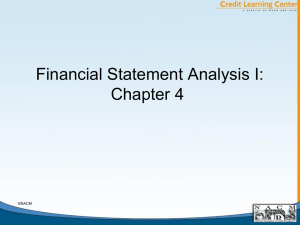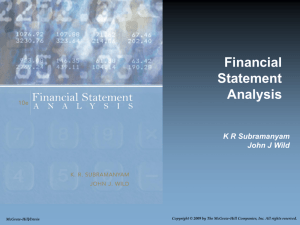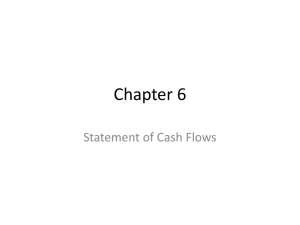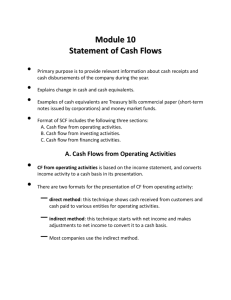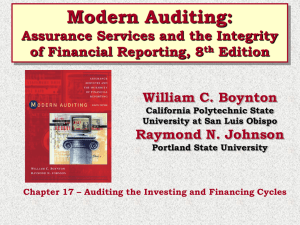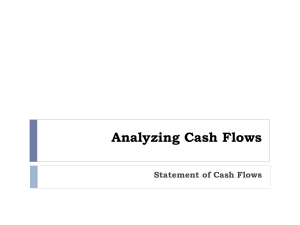Chapter 23
advertisement
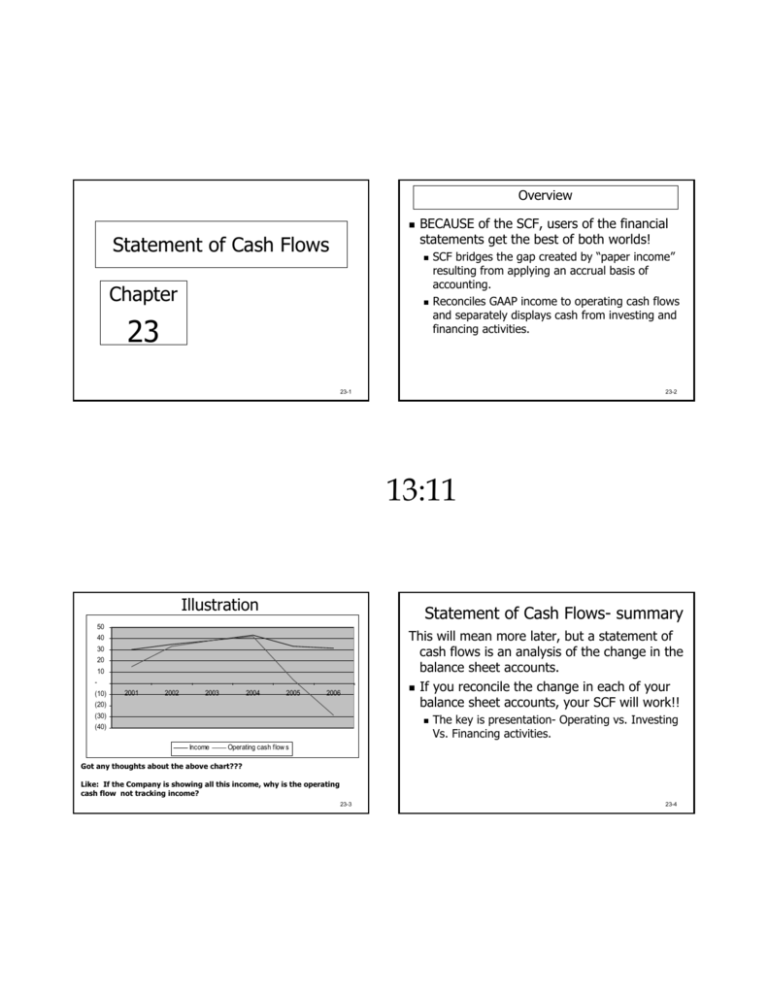
Overview Statement of Cash Flows BECAUSE of the SCF, users of the financial statements get the best of both worlds! Chapter 23 SCF bridges the gap created by “paper income” resulting from applying an accrual basis of accounting. Reconciles GAAP income to operating cash flows and separately displays cash from investing and financing activities. 23-1 23-2 13:11 Illustration Statement of Cash Flows- summary 50 40 30 20 10 (10) 2001 2002 2003 2004 2005 2006 (20) (30) This will mean more later, but a statement of cash flows is an analysis of the change in the balance sheet accounts. If you reconcile the change in each of your balance sheet accounts, your SCF will work!! (40) Income The key is presentation- Operating vs. Investing Vs. Financing activities. Operating cash flow s Got any thoughts about the above chart??? Like: If the Company is showing all this income, why is the operating cash flow not tracking income? 23-3 23-4 Cash from operations: Shows the cash provided by operations Typical presentation called “indirect” because it reconciles the net income (accrual) to cash from operations. Think of it as net income, adjusted for non-cash activities, including changes in current assets Cash from investing: Gross! Shows cash from investing activities Think of it as cash from long-term assets, similar to unusual items in the income statement. Cash from financing: Gross! Shows cash from financing activities Think of it as cash from borrowing and equity transactions 23-5 STATEMENT OF CASH FLOWS EXAMPLE Overview- how it works 23-6 13:11 Operating section- Indirect Method ASSUMED ACTIVITY: Reconciles net income to cash flows from operations by: Starts with net income and seeks to reconcile that number to the cash actually generated from operations Removes non-cash items, like depreciation & amortization Removes items which will be presented in the investing and financing sections separately i.e remove gains from sales of long-term assets Shows changes in current assets Operating section illustration Think about it- if A/R increased $100k, how does this impact cash? 23-7 Opening balance Sales on credit Cash sales Collections Opening balance Sales on credit Cash sales Collections Ending Change in A/R 1,000,000 10,000,000 100,000 9,500,000 Accounts Receivable 1,000,000 10,000,000 NET INCOME (10,000,000) (100,000) (9,500,000) 1,500,000 500,000 (10,100,000) HOW THE STATEMENT OF CASH FLOWS WOULD APPEAR: Net income Adjustments to reconcile net income to cash provided by operations: Increase in accounts receivable Cash provided by operations 10,100,000 (500,000) 9,600,000 LETS CHECK IT- FROM ABOVE We collected 9,500,000 We made cash sales 100,000 9,600,000 23-8 Investing illustration Investing section Now that the operating section reflects ONLY operating activities, this section shows just the cash from investing activities (principally buying and selling long-term assets) Presented gross-for instance a sale of a fixed asset for a gain: The gain is shown as a reduction from net income in the operating section The proceeds are shown as a source of cash This works out to reflect the change in fixed assets. See next slide Fixed asset Beginning of year Sold Ending Accumulated depreciation Beginning of year Cy Depreciation expense Sold Ending 100,000 (100,000) 70,000 5,000 (75,000) - How much did fixed assets change by? 30,000 In the operating section we pull out the non-cash depreciation expense: Depreciation expense Gain on sale 5,000 75,000 Sell the thing for $100k: Purchase price NBV at sale Gain on sale 100,000 (25,000) 75,000 In the investing section we show: Cash proceeds from sale of fixed assets 100,000 In the statement of cash flows we have accounted change of $30,000: Operating section adjustments: Depreciation back-out Gain back-out INVESTING section: Proceeds from sale WOW- PRESENTING IT THIS WAY REFLECTS THE CHANGE! 23-9 for the 5,000 (75,000) 100,000 30,000 23-10 13:11 FINANCING ACTIVITY EXAMPLE Financing section Now that the operating section reflects ONLY operating activities, this section shows just the cash from financing activities (principally cash received and paid to borrow money and complete equity transactions) Presented gross-for instance borrow $1 million and repay $250,000 under a line of credit: The borrowings of $1million are shown as cash provided by financing (positive cash); The repayment of $250,000 is shown as a repayment (negative cash) NOTICE that combined they represent the change in that 23-11 Remember that we are trying to reconcile the change in each of the balance sheet accounts. So if debt increased by $10, but the company’s activity were to borrow $1 million and repaid $999,990 (net $10 change), the statement of cash flows would reflect the “activity” and would look like this: Cash flows from financing activities: Borrowings from bank Repayments under loans Cash flows from financing activities $1,000,000 $ 999,990 $ 10 23-12 SO HOW DO WE DO IT? Cash A/R Inventory Fixed assets Accumulated depr. TOTAL ASSETS First, you need: Balance sheet Income statement Equity statement 12/31/2004 12/31/2003 CHANGE Operating Net Income 10,000 12,000 (2,000) N/A 70,000 65,000 5,000 (5,000) 500,000 425,000 75,000 (75,000) 580,000 502,000 A/P Debt 75,000 400,000 70,000 400,000 5,000 - 10,000 95,000 580,000 NET INCOME FOR 2004 WAS 10,000 22,000 502,000 73,000 73,000 common stock retained earnings TOTAL LIAB & EQTY Then, you compute the change in each item on the balance sheet. Unaccounted For n/a 5,000 - 73,000 XYZ, Inc. Statement of Cash Flows Year Ended December 31, 2004 73,000 (5,000) (75,000) 5,000 (2,000) Cash flows from investing and financing activities: NONE IN THIS EXAMPLE Then you post them all over the the statement of cash flows! - B/C all accounted for, we are ready to do SCF! Cash flows from operating acitivities: Net income Adjustments to reconcile net income to net cash from operations Increase in accounts receivable Increase in inventory Increase in accounts payable Net cash USED in operating activities For each change, allocate to: Operating, investing or financing - - Net decrease in cash (2,000) Cash at the beginning of the year Cash at the end of the year 12,000 10,000 23-13 23-14 OKAY, MORE DIFFICULT Prepare the statement of cash flows for ABC, Inc. based on the following information: The comparative balance sheet and income statement are on the next slide. Equity transactions are as follows: Sold stock for $10,000 cash Declared and paid dividends of $5,000 Long-term assets and liabilities Borrowed $100,000, repaid $50,000 Purchased a warehouse with $1 million in cash and assumed an existing $8 million loan; Sold equipment for $200,000 resulting in a gain of $190,000 (net book value was 10,000 representing 500,00 of equipment with 490,000 of accumulated depreciation). BALANCE SHEET & INC. STMT. 13:11 Cash Accounts receivable Inventory Prepaid expenses Total current assets Fixed assets At cost accumulated depreciation Lease commissions At cost accumulated amortization Total assets Accounts payable Accrued expenses Current portion of debt LT Debt Common stock Retained earnings Total liabilities & Equity 23-15 ABC, Inc. Income statement Year Ended December 31, 2004 ABC, Inc. Balance Sheets December 31 2004 225,000 265,000 1,000,000 10,000 1,500,000 2003 100,000 250,000 500,000 12,000 862,000 18,500,000 (6,210,000) 12,290,000 10,000,000 (6,500,000) 3,500,000 1,250,000 (725,000) 525,000 14,315,000 1,250,000 (700,000) 550,000 4,912,000 433,000 150,000 50,000 500,000 175,000 50,000 10,050,000 2,000,000 110,000 3,522,000 100,000 2,087,000 14,315,000 4,912,000 Sales COS Gross Profit SG&A expense Interest expense Depreciation expense Amortization expense Income from recurring op's 10,000,000 7,000,000 3,000,000 750,000 200,000 25,000 2,025,000 Gain on disposal of f. assets 190,000 Income before income taxes Income tax provision 2,215,000 775,000 Net income 1,440,000 Equity transactions are as follows: Sold stock for $10,000 cash Declared and paid dividends of $5,000 Long-term assets and liabilities: Borrowed $100,000, repaid $50,000 Purchased a warehouse with $1 million in cash and assumed an existing $8 million loan; Sold equipment for $200,000 resulting in a gain of $190,000 (net book value was 10,000 representing 500,00 of equipment with 490,000 of accumulated 23-16 depreciation). Cash Accounts receivable Inventory Prepaid expenses Fixed assets, net Cap. Com At cost Accounts payable Accrued expenses All debt Common stock Retained earnings To Deprec. Change Operating Gain & Amort. 125,000 n/a 15,000 (15,000) 500,000 (500,000) (2,000) 2,000 8,790,000 (190,000) 200,000 (25,000) 25,000 (67,000) (67,000) (25,000) (25,000) 8,050,000 10,000 1,435,000 Cash Purchase N-Cash Purchase (1,000,000) (8,000,000) Proceeds sale asset Borrow Repay Stock Sale Dividends Net incom 200,000 8,000,000 100,000 (50,000) 10,000 (5,000) 1,440,000 LEFTOVER n/a - ABC, Inc. Statement of Cash Flows Year ended December 31, 2004 Cash flows from operating activities: Net Income Adjustments to reconcile net income to net cash from operating activities: Depreciation & amortization Gain on disposal of fixed asset Increase in accounts receivable Increase in inventory Decrease in prepaid expenses Decrease in accounts payable Decrease in accrued expenses Cash provided by operating activities Cash flows from investing activities Purchase of warehouse Proceeds from sale of fixed assets Cash used in investing activities Cash flows from financing activities Borrowings Repayments Stock sold for cash Dividends paid Cash provided by financing activities Net increase in cash Cash at the beginning of the year Cash at the end of the year Supplemental disclosure of non-cash investing and financing activity Portion of warehouse purchase funded by assumption of debt 1,440,000 225,000 (190,000) (15,000) (500,000) 2,000 (67,000) (25,000) 870,000 SOLUTION (1,000,000) 200,000 (800,000) DIRECT VS. INDIRECT Everything we just did is the “Indirect” method. The INDIRECT METHOD which is by far the most common. There is a “Direct” method as well. The only difference is in the operating section- financing and investing sections are exactly the same either way The indirect method is called “indirect” because it reconciles net income to cash from operations—i.e indirectly determines cash from operations by starting with a noncash-based number and reconciling to the cash-based number: 100,000 (50,000) 10,000 (5,000) 55,000 The direct method is called “direct” because it only shows the cash flows, rather than reconciling to them. 125,000 100,000 225,000 Strength: highlights the differences between net income and operating cash flows Strength: prominently displays cash receipts and payments. 8,000,000 23-17 23-18 13:11 DIRECT METHOD: LOOKS LIKE Cash flows from operating activities: Cash received from customers Cash payments: To suppliers For operating expenses For income taxes Net cash provided by operating activities Illustration of the two: $765,000 OPERATING SECTION (550,000) (148,000) ( 48,000) $ 19,000 Indirect Net income Adjustments to net income, such as Depreciation Gains on l-term assets Changes in current assets & liabilities Direct Cash received from customers Cash paid for inventory Cash paid for operating expenses Cash paid for income taxes THE ABOVE ITEMS ADD UP TO THE SAME AMOUNT OF OPERATING CASH FLOWS 23-19 INVESTING SECTION SAME FOR BOTH FINANCING SECTION SAME FOR BOTH 23-20 How do you compute: REQUIRED DISCLOSURE ETC. You simply perform a roll-forward for the operating assets and liabilities. (works on the same premise as reconciling from net income, but in reverse) If a Company has sales of $1,000,000 and accounts receivable went from $100,000 to $110,000, then cash received from customers is: Beginning A/R $ 100,000 Plus sales 1,000,000 Less Ending (110,000) Cash received MUST be $ 990,000 If reconciling cash and cash equivelants, use the term cash and cash equivelants in the SCF Show cash paid for interest, and cash paid for income taxes at the bottom of the statement Don’t forget to disclose non-cash investing and financing activities at the bottom of the statement 23-21 23-22 13:11 Problem 23-6, pg. 1261 10. 11. Insurance expense Prepaid insurance Retained earnings Amortization expense Retained earnings Trademark 5,000 7,500 12,500 1,250 1,250 2,500 22 23-23
